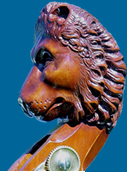|
|
|
|
|
|
LUTHIER
RANT
Fingerboards | Bass
Bars | Glues | Saddles
| Bridges
My Tuners | The
Sound Post | Regraduation
|
FINGERBOARD DRESSING My fingerboard dressing education was sorely lacking when I opened up shop - at least in terms if being able to achieve a very low action. I knew there were people out there who could but it was a mystery to me. Fortunately, I have a good friend named Ian who is a true wizard of fingerboard dressing. He knew that the answers were not in conventional viol lutherie but rather in electric bass technology. Those guys really knew how to get the lowest action possible and they were quite scientific about it. That's where he did his research. Of course, being his friend I got to steal all his secrets without doing any research myself. Sucker! It's really not a secret though; it's just a way of being more accurate and specific. Ian made me promise not to reveal details on the longitudinal relief, but there are a lot of little things that add up to accuracy on a fingerboard. One obvious place is in your tools. I've always been a tool junkie but I've recently started to really appreciate straight edges - I mean good ones. I've got a 48-incher that I paid $200 for. That may sound stupid, but when you're joining a top or back plate and your shooting for an invisible joint - it makes all the difference. I used to use the one you can get at Home Depot - whatta laugh. Back to boards - high quality straight edges are amazingly useful - I generally use a 24 in., a 12 in., a 6 in., and a 3 in. knife edge. Now, using an edge on the board without the strings in tension tell you very little. If the edge deviates from exactly parallel to the string path at all it will give you false readings. So I tune the bass up just enough that the strings are tight and they don't give much when you lay the edge up against them. Then I darken the room and shine a strong light under the edge. I do this with each of my edges and plane accordingly. This method enables ultimate accuracy in detecting any inequities in the string path. It also takes a lot more time. People don't realize how long it takes to do a good job in bass lutherie, and to exceed "good," time begins to increase exponentially. Woe to the luthier who feels compelled to do his dead level best all the time. I love planes. They are all interesting but here is another case where the most expensive ones may be worth the extra money. I'm partial to Lie-Nielsen planes - really good quality. It also helps to have different sizes to accomplish the proper relief. I use four different size planes to dress a fingerboard. Sharpening is critical here. I've been working on my sharpening skills for 20 years now and I still can't say I've got it down. But I'm constantly trying - I guess that is the point. Another useful tool is a white china marker. You can rub the underside of the string, play it, and any high spots will be readily marked. This can often save some guesswork. Years ago I had a client who had wrist problems and was after me to get really low action on his bass - especially on his E string. I went to hell and back and he still kept rattling that string. I was on the phone with Ian often about that. One thing he told me really helped. He said to put a white dot on the string and play it. This way you could see the cross section of the vibration. Very interesting. If you played arco, the cross section was an even ellipse, parallel to the bow stroke. Of course that wasn't where the noise was. Pizzicato was a different story. Plucked, the cross section formed a kind of weird T with a spike down into the board. It is so clearly visible that it can be measured. When I realized how large the spike was, I saw that I was on a wild goose chase. There were 5/32in. under the string and that was exactly the size of the spike. No can do. That really gave me a method to know exactly how little clearance is possible under the string at any point. It all varies with the type of strings and the style of the player. A bassist using Spirocores trying to play loud in an unamplified setting cannot have an action that is "like buttah". But put on a set of Obligatos and get subtle and technical - get out your feeler gauges! page | 1 | 2 | |


| 359 Miller Avenue, Freeport, NY 11520 (516) 867 1395 · jbollbach17@gmail.com |
| [Directions to the workshop] |